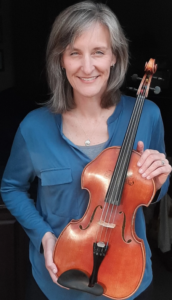Put a Bow on It
This is a story more than two years in the making. Amy Kniffen, Acting Associate Principal viola with the Indianapolis Symphony Orchestra since 1998, was on a quest...

This is a story more than two years in the making. Amy Kniffen, Acting Associate Principal viola with the Indianapolis Symphony Orchestra since 1998, was on a quest to find a new bow. After her bow broke right before an audition, she borrowed one from a teacher to get through, and then set out to find a replacement. She tested about 30 different bows and finally chose one, but it was too heavy. After a few years of trying to make it work, she tried about 30 more bows, but none seemed right. That is until she tried one made by the renowned French bowmaker Benoît Rolland. “I thought, if I like this bow so much that he made for someone else,” she said, “then maybe I’ll like one even more that he makes for me.”
So she added her name to Rolland’s commission list, which was more than two years long. And she waited. And waited. Finally, in 2018, she got the call that it was her turn. Taking her family on a trip out east to Boston where Rolland now lives and works, she played her viola for him and answered his questions. Rolland takes time to get to know each of his clients, working to match bow and musician perfectly. The Boston Globe said in a 2016 article, “He then forms what clients describe as an almost eerily insightful picture of a musical personality: one that can encompass the specific expressive contours of a performer’s style, and perhaps even hidden potentials waiting to be unlocked by the right bow.” Two months later, Kniffen got the call that the bow was ready.
Labor of love
Rolland learned his bowmaking skills from the last traditional master maker in France in the 1970s. He moved to Boston from Paris in 2001 and received the MacArthur Fellowship in 2012. He has made more than 1,500 bows for leading soloists around the world including Yo-Yo Ma, Anne-Sophie Mutter, and Mstislav Rostropovich. “The instrument produces the sound, but the bow makes the music,” Rolland explained in a 2016 interview. “It is the true conduit for the musician’s creative energy.”
Rolland made Kniffen’s bow out of rare Brazillian Pernambuco wood, usually considered to be the best possible wood for making bows. He received his stock of wood from an old French family of bowmakers who allowed him in the early 1980s to choose the planks of wood he would like from their supply. It is from that limited resource that Rolland selects a plank, cuts the sticks, then finds the perfect one to use for making a bow. “It’s a wildly reactive wood,” he explained in a 2016 journal posting. “The bows should be thrilling to play, exuding a palette of overtones, but will be nerve-wracking to build.”
Using his hands and no power tools or vices, Rolland listens to the wood as he shapes it, feeling its qualities and paying attention to the vibration it gives off. At the base of the bow on the frog—a part that moves to control tension on the hair—he sometimes uses mother of pearl and often uses gold and silver from France because it’s a higher-quality. “He’s extremely careful about his materials,” says Kniffen. “Even the horse hair he uses comes Siberian and Mongolian white stallions.”
Special delivery
When the bow finally arrived in Kniffen’s hands, she was smitten. “I loved it from the first moment,” she says. “It was such a beautiful sound and a great match for my instrument.” She plays a viola made by the Japanese artist Hiroshi Iizuka, and loves the quality of sound that it is able to produce. The bow is a perfect complement.
Kniffen appreciates Rolland for his ability to not only create perfect bows, but to make adaptions with the bow to keep it current. “He has all the classical training,” she says, “but he looks to the future to see what will carry the craft forward. He wants a bow that feels good in the hands and sounds good too, and one that will increase the musician’s ability to have joy in making music. After a year of using it and letting it settle, Kniffen is more than happy with the results. “I have a beautiful viola that is a pleasure to play and now I have a bow that is a lovely complement. It matches my instrument extremely well, feels good in the hand, and has a good depth and variety of sound. Life is good.”
